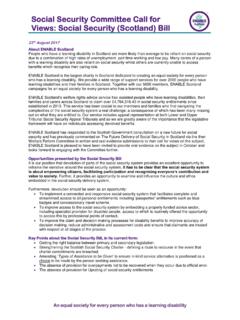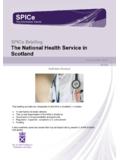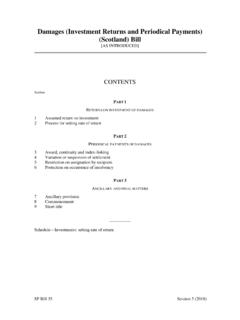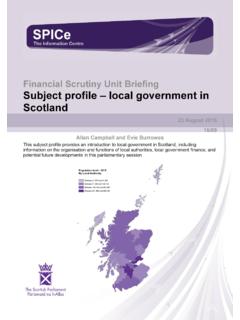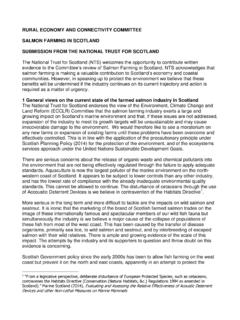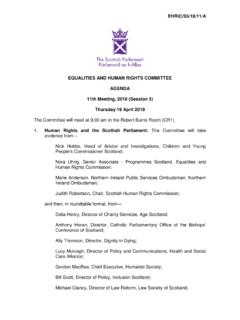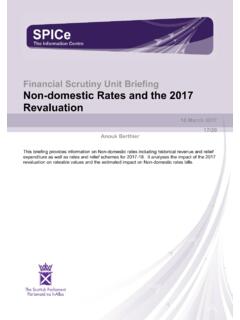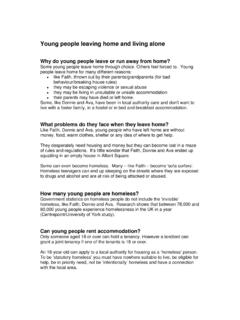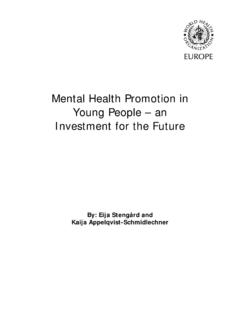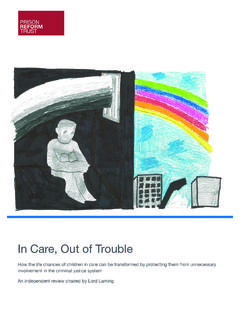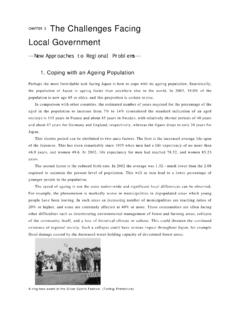Transcription of Local Government and Communities Committee …
1 H/42 1 Local Government and Communities Committee homelessness Submission from Simon Community Scotland Simon Community Scotland is the country s largest provider who are wholly focussed on service delivery to combat the causes and effects of homelessness . Our focus is on providing solutions for people with the most chronic and complex needs and who have long histories in homelessness , with a particular focus on the most extreme forms of homelessness including rough sleeping. The organisation engages with over 3000 people each year and works across multiple HSCP areas, delivering multi agency collaborative responses alongside providing emergency, temporary and longer term intensive supported accommodation models across 12 sites. Housing Options / homelessness Prevention 1. How do you feel housing options and homelessness prevention is working in practice? Are there examples of good practice?
2 Our experience of the impact of housing options centres around those with the most chronic, multiple and complex needs. The Housing Options process can prove difficult for our service users to link in with due to the complex nature of the issues they are affected by and the lengthy interview process is challenging to complete . Staff find the whole process in its entirety complicated never mind our service users. As a process for the general population it clearly offers a very effective diversionary process from homelessness , however it can also create further barriers for those in the midst of chaos and crisis and whose past experience of services may have been exclusion and the absence of any control or choice, which often leads the individual to self select to not participate in a full assessment. We also experience a very varied approach between HSCP and Local Authority areas, particularly where homelessness is not a devolved area to the the Local Integrated Joint Board, where fully integrated responses to individual need can be challenging and the focus remain on a housing led intervention.
3 H/42 2 2. How effective is the relationship between all the relevant agencies, including the health sector, and charities working on homelessness prevention? True prevention activities that work in advance of responding at the point of need, remain very limited, particularly restricted and/or completely absent is the role that health and specifically mental health and primary care might play in identifying those at risk and supporting a multi agency response to prevent risk escalating to a point where a housing options assessment is then required. 3. What needs to happen to improve the delivery of housing options and homelessness prevention services and the outcomes achieved for service users? We welcome the development of the Housing Options toolkit and look forward to seeing more consistency of approach and improved understanding as it is rolled out. There remains a challenge to make best use of the approach for the most vulnerable and to recognise that the more success we have in utilising housing options, to divert an increasing majority from statutory homelessness , the greater the intensity of complexity and need that we see within the homelessness system and accommodation, support and care arrangements require to focused on a rapid access to a settled home approach.
4 Furthermore we need to look beyond prevention at the point of need and work earlier to identify more of those at risk at a much earlier stage. We deliver a multi partner Support Officer Service in partnership with five community housing associations in the North of Glasgow that is aimed at upstream prevention. Referrals come from Housing Officers who identify support needs or access challenges with their tenants. There are many examples of the identified need relating to an apparent practical issue eg the need to gain access for gas maintenance and what emerges is evidence of significant risk factors that, once support and the appropriate connections are made, can be easily mitigated against. 4. What role should private sector housing provider s play in preventing and responding to homelessness ? Private sector housing undoubtedly remains under utilised in most areas, how we can increase the role it plays is largely determined by welfare reform, both in terms of landlord willingness to accommodate and housing contribution levels of Universal Credit being sufficient to meet rent levels.
5 We would welcome a pragmatic approach that recognises that there may be merit in underwriting shortfalls for individuals in housing contributions that goes beyond what is currently available to give sustainable solutions for individuals who would otherwise return to homelessness . H/42 3 Section 2 Temporary Accommodation 5. What evidence is there of pressure on temporary accommodation in your area? Has this increased in recent years? There is increasing pressure on temporary accommodation, we provide 125 places across three Local Authority areas. Lengths of stay have increased significantly with a particular issue being experienced We have examples of where pressure to accommodate individuals at risk of rough sleeping is high, requests are made for service users with somewhere else to go to give up their room for a night or This requires the service user to pack up and move all of their belongings out of their room then staff clean it ready for the next service user to move in within hours, seeing service users effectively sharing a room and potentially putting vulnerable people at risk within unsuitable relationships with no choice of return within the time they have agreed to be away.
6 Emergency accommodation service often has people on couches and camp beds to avoid to ensure people are not sleeping rough. We are beginning to see evidence of increased housing access barriers for those on Universal Credit, particularly in some areas with even more limited access to RSL and Private Rented Sector accommodation. This is resulting in longer stays within temporary accommodation. Many younger service users accommodated within our temporary accommodation services have stated that they would prefer to remain in hostel accommodation with other young people rather than move into a tenancy and risk isolation. No settled housing options exist for people who do not want to live alone. 6. How can homeless people s experiences of temporary accommodation be improved? For example, how can the use of unsuitable accommodation be reduced or the length of time spent in temporary accommodation reduced? We have major concerns about the nature of some of the temporary accommodation and the quality of the environment that is or can be offered.
7 Standards are often extremely poor, with very little resource available or directed towards maintaining even the most minimum of living standards. The over use of high cost temporary furnished accommodation precludes the vast majority of individuals from seeking employment and pursuing any training or education due to the personal liability for the rent and housing management charge. Diverting as many people as possible towards immediate access to settled accommodation with access to the support and health care they need, in line with the principles of Housing First, is a primary priority across the country. This could H/42 4 allow better targeting of resources to provide high quality and well supported temporary accommodation only for those who require further assessment or input before moving rapidly on to a settled home. The key aim must be to eliminate the use of any B & B or hotel accommodation and ensure that all temporary accommodation also delivers immediate access to support and housing advice.
8 7. Do you have concerns about the funding of temporary accommodation? If yes, how should temporary accommodation be funded? We have significant concerns about the reliance on individual housing benefit contribution to the sustainability of temporary accommodation services and we are already seeing significant deficits in funding due to the impact of welfare reform. Administration of housing benefit and UC Housing Contribution carries significant costs, that cannot be accounted for within a social care contract, the time taken to maintain an individual's rent contribution detracts from their support and care needs and diverts precious staff time into process. Section 3 Permanent Accommodation 8. How do social landlord s allocation policies prioritise applications from homeless households and how does choice based lettings work in practice? Choice based letting processes, are predominantly an online process, which introduces a significant barrier for many of the people most in need.
9 We recently surveyed service users in our accommodation services on whether they had ever had an email address and less than 20% answered positively and the majority of those were the under 25 s. Digital access and the ability to engage in online processes, no matter how simple is a huge barrier. Section 4 Multiple and Complex Needs 9. What more could be done to ensure that the needs of homeless people with multiple and complex needs are adequately supported? Are there examples of good practice? As an organisation with a primary focus on multiple and complex need homelessness we have been a lead partner in the development of a unique multi agency approach to reach and find solutions for the most chronic and vulnerable individuals in Glasgow. The initiative utilises the skills and knowledge of existing services and staff to deliver a highly individualised and assertive response. The CAN (City Ambition Network) is a third sector led partnership that was formed to find collaborative ways of working that could address the exceptional needs of vulnerable people who were in a chronically circular pattern of rough sleeping, H/42 5 addiction, incarceration, re-traumatisation and significant health and mental health inequalities.
10 This relatively small group of around 70 service users were crashing in and out of services with little sign or opportunity for that to change. The CAN brought organisations and crucially the right people together to take a collaborative, flexible and assertive response that has demonstrated significant life changing opportunities for the small number of people in the pilot stage. We are confident a number of people currently supported by the CAN would be dead if not for the work of the team. The CAN is now expanding its reach with the support of multi year funding from the Oak Foundation. The CAN has demonstrated the ability work in partnership to rethink service delivery, to come together for a shared vision and purpose and to reshape boundaries in supporting frontline staff to find the right solutions which previously would have been impossible due to system barriers and expectations.
